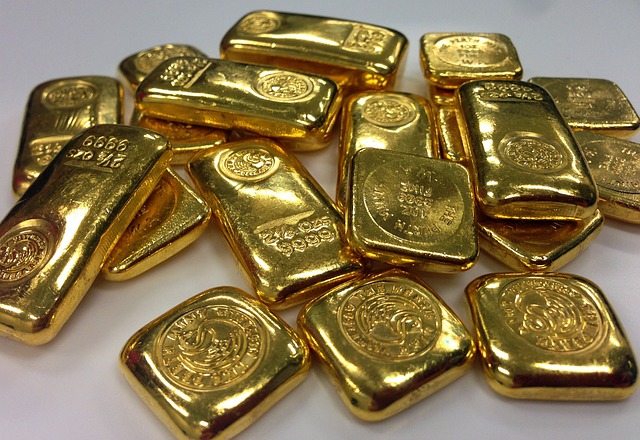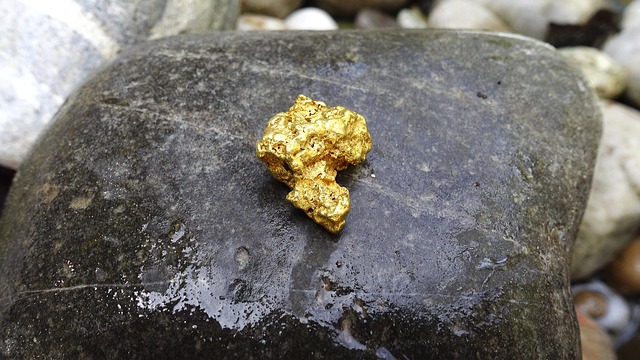Investing in gold within a self-directed IRA requires navigating specific IRS regulations. This involves selecting a custodian with expertise in managing self-directed IRAs that handle alternative assets like precious metals. The chosen custodian must ensure the gold investments meet IRS standards, including using approved coins and bullion stored in allocated accounts. Investors should diligently research to find both the custodian and the precision metals, ensuring they adhere to IRA rules, understand storage needs, and are aware of any additional fees or taxes. The process begins with establishing a new self-directed IRA and funding it through a transfer or rollover from an existing IRA. Investors then purchase IRS-approved gold that is stored in an IRS-approved depository to maintain the tax-advantaged status of their investment. Proper management of this process is crucial to avoid penalties and taxes, and to ensure the gold investments align with the investor's retirement goals and risk tolerance. It's important to stay informed on IRS guidelines and consult with professionals for guidance throughout this investment journey.
Navigating the intricacies of retirement planning often leads investors to explore alternative assets, such as precious metals. Among these, gold stands out for its historical value and potential to hedge against inflation and market volatility. This article demystifies the process of converting a traditional IRA into a gold investment by delving into the establishment of a self-directed IRA tailored for such assets. We will chart the straightforward steps required for this transition, select the optimal type of gold to safeguard your retirement savings, and address the critical compliance and tax implications. By understanding these aspects, you can make informed decisions to diversify your retirement portfolio with the timeless allure of gold.
- Understanding Self-Directed IRAs for Precious Metals
- Steps to Convert Traditional IRA to Gold
- Selecting a Trustee for Your Self-Directed IRA
- Choosing the Right Type of Gold for Your IRA Investment
- Compliance and Tax Considerations When Investing in Gold with an I
Understanding Self-Directed IRAs for Precious Metals

Navigating the transition of a traditional IRA to one that includes gold or other precious metals requires familiarity with self-directed IRAs. These specialized accounts afford investors the opportunity to diversify their retirement portfolios beyond conventional stocks, bonds, and mutual funds. A self-directed IRA for precious metals allows for the purchase of IRS-approved coins and bullion as part of an individual’s retirement savings strategy.
To initiate this process, one must first select a custodian that specializes in self-directed IRAs with the capacity to handle alternative assets like precious metals. This custodian will facilitate the transaction, ensuring compliance with IRS regulations. Investors are then able to purchase IRS-approved metals, such as gold, silver, platinum, and palladium, which can be held in an allocated account specifically designed for physical precious metals. It’s crucial to conduct thorough due diligence on both the custodian and the metals to ensure they meet the necessary standards for inclusion within a self-directed IRA. This due diligence includes understanding the types of metals allowed, the storage requirements, and any associated fees or taxes. By understanding these elements, investors can make informed decisions that align with their retirement savings goals and investment risk tolerance.
Steps to Convert Traditional IRA to Gold

To transition a traditional IRA into an investment in gold, individuals must navigate a series of steps designed to comply with Internal Revenue Service (IRS) regulations. The initial step involves researching and selecting a self-directed IRA custodian that is experienced in handling precious metals. This custodian will oversee the transaction and ensure compliance with IRS rules. Once a reputable custodian is chosen, account owners must establish their new self-directed IRA and fund it by transferring or rolling over funds from their traditional IRA. The transferred funds can be sent directly to the new custodian, typically through a trustee-to-trustee transfer to avoid any taxable distribution.
After the new account is funded, investors must then purchase IRS-approved gold coins or bullion. The IRS specifies that only certain types of gold can be held within an IRA, such as American Gold Eagles, American Buffalo gold bullion, and certain gold bars. Investors are advised to work closely with their custodian to ensure that the purchased metals meet these specifications. Upon acquisition, the gold must be stored with a third-party depository approved by the IRS, further ensuring the security and legality of the investment within the tax-advantaged account framework. Throughout this process, it is crucial to adhere to all IRS guidelines to maintain the tax-exempt status of the IRA and avoid any penalties or taxes on the transaction.
Selecting a Trustee for Your Self-Directed IRA

When considering the conversion of your traditional IRA to a self-directed IRA that invests in gold or other precious metals, selecting a reputable trustee is paramount. The trustee you choose will play a critical role in the management and oversight of your investments within this specialized account. This trustee must be knowledgeable in the regulations governing self-directed IRAs and the specific rules that apply to alternative assets like precious metals. They should have experience with transactions involving these types of investments and provide guidance on compliance matters, ensuring that your holdings adhere to the Internal Revenue Service (IRS) guidelines.
Moreover, the trustee must be a custodian that is approved by the IRS to hold such assets. It’s crucial to conduct due diligence when selecting this entity, as they are responsible for safeguarding your investments and maintaining accurate records of all transactions. The trustee will also coordinate with a third-party depository for storing your physical gold in a secure environment, which is often required by the IRS for these types of IRAs to ensure the metals are properly insured and protected. By carefully choosing a trustworthy and experienced trustee, you can navigate the complexities of investing in precious metals within an IRA with greater confidence and security.
Choosing the Right Type of Gold for Your IRA Investment

When considering the conversion of a traditional IRA to a self-directed IRA that includes gold investments, it’s crucial to select the appropriate type of gold that aligns with your investment goals and the regulations governing IRS-approved precious metals. The Internal Revenue Service (IRS) stipulates specific eligibility requirements for gold and other precious metals to be held within an IRA. Among the permissible options are American Gold Eagles, American Buffalo gold coins, and certain gold bars or ingots that meet the purity standards set by the Commodity Futures Trading Commission (CFTC) and the London Bullion Market Association (LBMA).
Investors should evaluate factors such as purity, storage, liquidity, and the historical performance of different types of gold when making their selection. For instance, coins often come with a premium for collectibility but offer ease of transfer into an IRA account. Bullion bars, on the other hand, may have lower premiums over the spot price of gold but require secure storage arrangements. It’s also essential to consider the tax implications and potential penalties for early withdrawal when managing these investments within your retirement account. By thoroughly researching and consulting with a financial advisor or precious metals expert, you can make an informed decision on the type of gold that will serve as a robust component of your long-term investment strategy.
Compliance and Tax Considerations When Investing in Gold with an I

When considering the conversion of a traditional Individual Retirement Account (IRA) to include gold investments, adherence to compliance and understanding of tax implications are paramount. The Internal Revenue Service (IRS) stipulates specific rules that govern IRA investments, particularly those involving precious metals. To comply with these regulations, investors must ensure their self-directed IRA is set up with a custodian that specializes in alternative assets, including gold. This custodian will oversee the storage and transactions of the physical gold within the IRA framework, ensuring it meets the IRS’ purity standards for coins and bullion.
Furthermore, investors must be cognizant of the tax treatments associated with such investments. While the growth within a traditional IRA is tax-deferred, early withdrawal before reaching retirement age may trigger taxes and penalties. However, once in retirement, distribution from a gold-backed IRA is treated like any other IRA distribution for tax purposes. The value of the gold upon distribution will be subject to capital gains tax, based on the difference between its sale price and its cost basis. It’s also crucial to monitor the reporting requirements, as the IRS requires detailed documentation of all transactions involving precious metals within an IRA. Regularly reviewing the IRS’ current guidelines and consultating with a tax professional can help navigate these complexities effectively.
navigating the process of converting a traditional IRA to gold involves establishing a self-directed IRA that permits precious metals investments. This article has outlined the critical steps, from selecting a compliant trustee to determining the optimal type of gold for your retirement portfolio. It is imperative to consider the tax implications and regulatory compliance associated with this unique investment strategy. By following the guidelines provided, individuals can prudently incorporate physical gold into their IRA, diversifying their retirement assets in a manner that aligns with their financial goals and risk tolerance.
